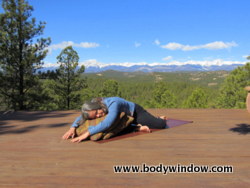| Back to Back Issues Page | ||||||||
 |
||||||||
|
Hello Welcome to In the Moment with the Pigeon Pose! June 23, 2013 |
||||||||
In the Moment with the Pigeon Pose or "Broken" Pigeon!
|
 Begin in Table Top Pose |
 Full Upright Pigeon Pose |
 One-Half Lying Pigeon Pose, Supported on Elbows |
 Full Lying Pigeon Pose |
 Lying Pigeon Pose, Supported with Cushions |
 Broken Pigeon Pose |
 Broken Pigeon Pose, Supported with Cushions, in Upright Position |
 Lying, Broken Pigeon Pose, Supported with Cushions |
Now lift your knees, sending your weight to your feet and hands. Bring your right knee forward, bending it as you sit down on your hips, front leg bent under you, and back leg straight back behind you as shown in the second picture.
Try to keep your hips square toward the front and place the palms of your hands on the ground on either side of your knee. If your front knee does not feel safe and comfortable, go immediately to the description for the Broken Pigeon.
If your hips feel too tight and are sending you the message of more than mild pain, go immediately to the Broken Pigeon.
If you are not sure if you can do the full pigeon pose, notice your breathing. Did you hold your breath? Are you grimacing or grunting to hold this pose? If yes, go immediately to the Broken Pigeon.
Do not judge your ability or lack of flexibility. Be kind to yourself and your body, where it is in this moment. Over time and with practice and intention, your hips will open up.
If your knees and hips feel safe in this upright pigeon pose, on your next inhale, move your upper body down so that your elbows are supported on the ground as shown in the third photo. Breathe deeply into any opening that is trying to happen in your hips. The tug should be a mild discomfort, a small tug in your joint.
If the elbow-supported position feels like it is not enough of an edge, go ahead and lie down with your upper body on the floor. If you feel drawn to more support, place a cushion or two under your chest to increase your ability to hold this pose for a full 3-5 minutes.
If you chose the Broken Pigeon Pose, instead of the full version, keep your back leg bent. Experiment with how deep you want the bend to be. Find a comfortable, yet edgy place, where you are working on your hip just enough, but not too much.
Inhale deeply and send your focus and therefore your breath to the area that you are inviting to release. If your body feels safe and comfortable, go ahead and place one or two cushions under your chest, as you lower your torso towards the ground. Only go as far as you can breathe deeply and send healing, opening energy to your hips. You may remove the cushion(s) in the broken pigeon pose, as your heart draws you deeper into to the pose over the 3-5 minute hold.
The wait and the weight will allow you to sink lower, as you hold the pose.
Slowly come out of the pose after 3-5 minutes, continuing to breath deeply. Raise yourself back to Table Top OR to the Downward Dog, if you know it, to stretch and release your hips. You may also rest in the Child's Pose for awhile, before going to the other side. Be sure you do the other side for as long as the first to maintain your balance. When you finish the other side, come out to the Downward Dog, the Table Top and/or the Child's Pose as your heart desires.
You may wish to say the following affirmations when you do this body moment movement:
“I open my body and my hips for release!”
“I open my heart for surrender!”
“I open to release my tension!”
“I release old tensions and hurts from deep in my being!”
“I am open for new energy!”
You may find that the hips are full of old hurts and old emotions. Many feel the urge to cry when they begin a practice of opening their hips. The hips are a storehouse of energy and emotion, especially in women and those who are in-tune.
Stay present with your experience and let any emotions flow. It will feel cleansing, releasing and will open you for more positive energy, when the old is cleared.
May you always be introspective and use your intuition when you do your healing meditations. May your Body Window messages be heard, honored and cared for!